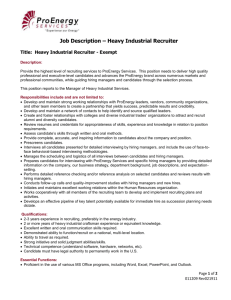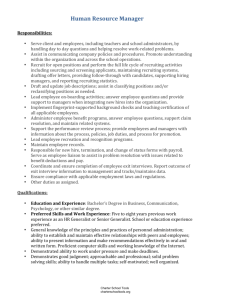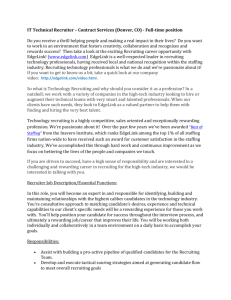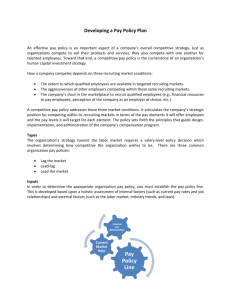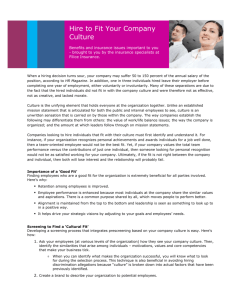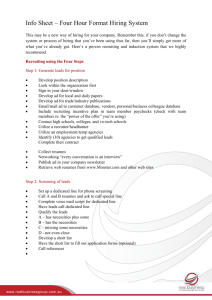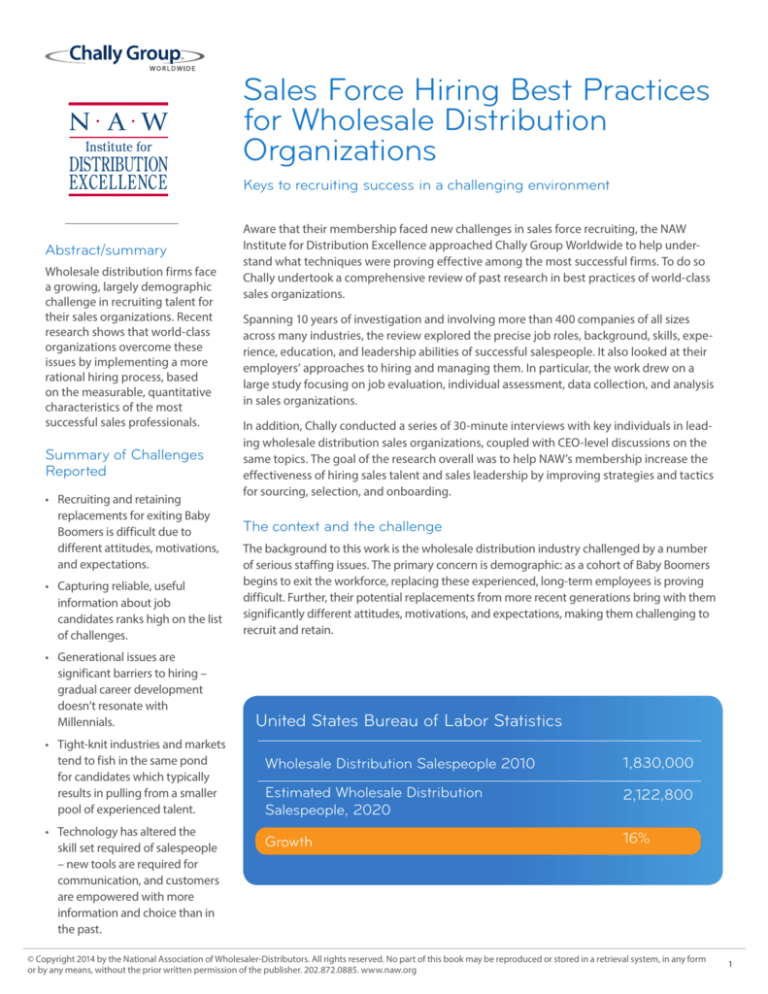
Sales Force Hiring Best Practices
for Wholesale Distribution
Organizations
Keys to recruiting success in a challenging environment
Abstract/summary
Wholesale distribution firms face
a growing, largely demographic
challenge in recruiting talent for
their sales organizations. Recent
research shows that world-class
organizations overcome these
issues by implementing a more
rational hiring process, based
on the measurable, quantitative
characteristics of the most
successful sales professionals.
Summary of Challenges
Reported
• Recruiting and retaining
replacements for exiting Baby
Boomers is difficult due to
different attitudes, motivations,
and expectations.
• Capturing reliable, useful
information about job
candidates ranks high on the list
of challenges.
• Generational issues are
significant barriers to hiring –
gradual career development
doesn’t resonate with
Millennials.
• Tight-knit industries and markets
tend to fish in the same pond
for candidates which typically
results in pulling from a smaller
pool of experienced talent.
• Technology has altered the
skill set required of salespeople
– new tools are required for
communication, and customers
are empowered with more
information and choice than in
the past.
Aware that their membership faced new challenges in sales force recruiting, the NAW
Institute for Distribution Excellence approached Chally Group Worldwide to help understand what techniques were proving effective among the most successful firms. To do so
Chally undertook a comprehensive review of past research in best practices of world-class
sales organizations.
Spanning 10 years of investigation and involving more than 400 companies of all sizes
across many industries, the review explored the precise job roles, background, skills, experience, education, and leadership abilities of successful salespeople. It also looked at their
employers’ approaches to hiring and managing them. In particular, the work drew on a
large study focusing on job evaluation, individual assessment, data collection, and analysis
in sales organizations.
In addition, Chally conducted a series of 30-minute interviews with key individuals in leading wholesale distribution sales organizations, coupled with CEO-level discussions on the
same topics. The goal of the research overall was to help NAW’s membership increase the
effectiveness of hiring sales talent and sales leadership by improving strategies and tactics
for sourcing, selection, and onboarding.
The context and the challenge
The background to this work is the wholesale distribution industry challenged by a number
of serious staffing issues. The primary concern is demographic: as a cohort of Baby Boomers
begins to exit the workforce, replacing these experienced, long-term employees is proving
difficult. Further, their potential replacements from more recent generations bring with them
significantly different attitudes, motivations, and expectations, making them challenging to
recruit and retain.
United States Bureau of Labor Statistics
Wholesale Distribution Salespeople 2010
1,830,000
Estimated Wholesale Distribution
Salespeople, 2020
2,122,800
Growth
16%
© Copyright 2014 by the National Association of Wholesaler-Distributors. All rights reserved. No part of this book may be reproduced or stored in a retrieval system, in any form
or by any means, without the prior written permission of the publisher. 202.872.0885. www.naw.org
1
Finally, the nature of the wholesale distribution business itself poses a recruiting challenge. A long-term
position in an industry of forklifts, totes, and narrow
margins is simply not interesting to many Millennials.
Organizations find it increasingly difficult to identify, hire, and keep younger sales candidates who will
thrive in this environment.
The NAW Institute’s goal in commissioning the study
is to help their membership understand and adopt
best-practice hiring methods that will:
•
Reduce cost to source promising candidates
•
Reduce onboarding investment and ramp time
•
Increase sales productivity
•
Manage turnover of new hires
•
Provide for future flexibility and potential growth
Barriers to successful recruiting
The first study area involved barriers to hiring
as seen by employers. Simply capturing reliable,
useful information about candidates ranks high
on many firms’ list of challenges. Résumé padding,
the reluctance of companies to share information
about former employees, and broader habits of
secrecy among close competitors all conspire to keep
potential employers in the dark about a candidate’s
true potential. Even something as seemingly factual as
work history is problematic: it can be unclear whether
job changes are a function of high performance
and career advancement, or poor performance and
washout.
Another commonly reported challenge is the need
for industry knowledge. Candidates with both expertise in a specific industry and outstanding sales skills
are often rare. However, the research indicates that
demonstrable sales ability is usually more predictive of
success than any specific knowledge or experience, so
this barrier may be somewhat overstated.
The effects of the ongoing information revolution are
more concerning. Technology has altered the skill set
required of salespeople, rapidly and sometimes dramatically. New tools for communication, tracking, and
analysis require mastery. More importantly, today’s
business-to-business customer is empowered with far
more information and choice than in the past, accelerating the sales process and pushing buying relationships toward the transactional end of the spectrum.
Finally, many respondents also cite generational issues
as significant barriers to hiring. Millennials often bring
expectations of rapid ramp-up, success, and advancement that are at odds with the norms of organizations
run by older managers. The implicit offer of gradual
career development in exchange for a long-term commitment doesn’t resonate with candidates who have
little interest in waiting their turn. Regardless of whose
expectations might be considered unrealistic today,
both sides of the generational divide seem to have
difficulty communicating with each other.
Self-inflicted issues
To these external challenges, we might also add some
“self-inflicted” barriers to effective recruiting. These
originate in the attitudes and approaches of the hiring
organization itself. Perhaps the most common is the
habit of waiting until an urgent staffing need arises to
devote substantial effort to recruiting. At this point,
it may already be too late to find and hire the best
possible candidates.
Another common issue is the tendency of all competitors
to “fish in the same pond.” Particularly in tightlyknit industries or regional markets for distributors,
organizations tend to seek candidates from a small
pool of familiar faces, some of whom may have worked
at various times for almost every firm in their space.
This is ironic, because an informal recruiting strategy
can be highly effective. However, it should be pursued
methodically and continuously, rather than on an
as-needed basis. And it must focus on specific job
qualifications rather than experience or familiarity.
The starting point:
Understanding candidate qualifications
This is the starting point for best-practice hiring:
identify very specifically what qualities you seek in
the ideal candidate. Before addressing techniques for
developing this set of qualifications for any given job,
a few overall guidelines should be mentioned.
Success through failure
In beginning this process, it can be useful to take a
further step backward: rather than ask how people
succeed, look at how they fail. This approach has
numerous benefits. It offers a new way to think about
jobs and people that can stimulate fresh insights. It
helps weed out deal-breaking issues immediately,
while retaining applicants who have the potential to
develop in more positive directions on the job.
© Copyright 2014 by the National Association of Wholesaler-Distributors. All rights reserved. No part of this book may be reproduced or stored in a retrieval system, in any form
or by any means, without the prior written permission of the publisher. 202.872.0885. www.naw.org
2
When articulated in the job posting itself, recognizing common failure points also allows the unsuitable
to filter themselves. Most candidates believe they’ll
succeed in the job or they wouldn’t bother applying. If
issues such as spending a high proportion of time on
the road or low levels of supervision are clearly spelled
out, people who are most affected by them may save
everyone the trouble of applying. The result is a higher-quality candidate pipeline.
Measure, analyze, repeat
Perhaps the most important practice of world-class
distributor hiring organizations is to favor quantitative
measures over qualitative observations. In particular, an
analysis of the specific, measurable competencies that
can be shown to predict success in a specific role is the
gold standard.
Larger companies tend to come closer to achieving this
goal, perhaps because they are already accustomed to
managing complex data in other areas of the business.
Smaller firms are less numbers-driven. While sales organizations are often very good at tracking anything with
a dollar value, they typically define other measures of
success much more loosely.
This is understandable considering the substantial
effort – or even the shift in attitudes – required to create
a robust, quantitative staffing model. Like total quality
or operational efficiency, data-driven hiring may be
more of an aspirational goal than a concrete objective
for some organizations, at least for the present. But it is
likewise well worth pursuing.
Best practices part one:
Defining specific, usable
job qualifications
A cardinal rule of best-practice hiring is that the
qualifications for a given position should match the
nature of the job as specifically as possible. This makes
it imprudent to generalize too much, even within a
category such as wholesale sales professionals. But, at
a high level, the following considerations stand out.
Seek customer feedback
The most valuable information comes from the
customer. While much of this will be anecdotal, top
distribution companies take extra steps to collect
quantitative information that they can use to craft a
metrics-driven approach to hiring.
Develop detailed selection criteria
Specifically, top distribution companies review the
data carefully to determine what skills or capabilities
differentiate the most effective salespeople. These
go beyond “likeable, helpful, tenacious.” The skills or
capabilities should include enough definition and
detail to be useful in the selection process, besides
being predictive of success in the job as perceived by
the customer.
Keep selection criteria limited
Job descriptions often list extensive, overlapping, and
even contradictory requirements. These also tend
to be overly broad. Analyze the value statements
provided by the customer to build a short, accurate list
of the capabilities a successful sales rep must bring to
the engagement. The distributor’s customers are the
single best source of information on what it takes to
be successful when calling on their businesses.
Define “sales”
The distributor sales environment can range from
routine, low-value transactions via phone or email to
complex, high-value and high-risk deals that demand
extensive research, teamwork, and customer collaboration. Consider where your organization’s sales efforts
lie along this spectrum and analyze sales jobs in this
context as specifically as possible.
Look for the customer advocate
Almost without exception, customers of world-class
sales organizations value a salesperson whom they
feel is an advocate. They describe the ideal rep as
someone who “knows how to get things done,”
“makes things happen,” or “understands our business and our challenges.” This seems to confirm the
conventional wisdom that a focus on solving customer
problems is what differentiates the best salespeople.
© Copyright 2014 by the National Association of Wholesaler-Distributors. All rights reserved. No part of this book may be reproduced or stored in a retrieval system, in any form
or by any means, without the prior written permission of the publisher. 202.872.0885. www.naw.org
3
Seek business acumen
one or the other, not both. Experience shows that it’s
much easier to teach technical skills to someone with
sales ability than the other way around. Therefore, any
technical qualifications in a job description should be
scrutinized to make sure they’re
absolutely necessary.
The customer’s concerns, however, are much broader
in scope than any sales transaction. Research shows
that customers appreciate an
understanding of their overall
business needs. This capabil“Become a resource of the
Finally, experience specific to a
ity is related to the problem
customer – keys are:
given industry is often cited as a
solving above, but at a higher
Smart, Smart, Smart
critical requirement. Interestingly,
conceptual level – one not
Hunter – Natural born killer – love
the research indicates that such
commonly associated with
to prospect – New accounts
experience does not necessarily
sales teams. We were advised
Passion
–
compelling,
questioning”
bring with it any unique skills or
by distributors interviewed in
this process that driving the
Industrial Packaging Distributor differentiating business competence. However, there does
customer’s profitability must
appear to be a positive correlation
be a priority for the successful
with ramp time, as an experienced
rep. Success is measured by the amount of earnings
new hire will be able to “speak the language” from day
improvement delivered to the customer as a result of
one. And, while data are not available to support the
the relationship with the distributor. Understanding
point, common sense suggests that a wholesale disthe customers of the customer and how to best serve
tribution industry veteran is more likely to bring more
their needs differentiates the best-in-class distributor
of the personal relationships that are important in a
sales rep.
complex, high-value sales environment.
“
Education, training, and experience
Together these three factors play the leading roles
in most selection decisions. While the details will,
of course, depend on the job, the research suggests
several overall considerations. For example, education
can be used as a proxy for qualities that are difficult to
quantify: maturity and commitment. Completion of a
rigorous course of study may indicate that a student
has the intelligence, ability, and drive to work toward a
long-term outcome.
Training in advanced classes designed to prepare
students for a career in sales was cited as an
exceptional indicator for future success. New sales
reps, trained at one of the universities that has
developed a sales curriculum and a course of study
targeted at preparing students for a career in sales,
were identified as high probability investments.
According to one distributor, “these graduates are
fearless, educated, technologically capable and in very
high demand.”
Best practices part two:
Sourcing the best candidates
To the uninitiated, some of the above recommendations
for defining what hiring organizations should seek in
a sales professional may seem like an awkward cross
between an engineering project and a philosophical
exercise. Fortunately, the questions of where and how to
seek promising candidates are more straightforward. The
research offers a number of considerations.
University programs
Academia is an important focus for a number of developing recruiting efforts, particularly when technical
education is a prerequisite. However, the best students
typically don’t see sales as a compelling career choice,
and the most “technical” people may not be a good fit
for sales roles. Those with both technical degrees and
business training are highly sought-after.
Advanced technical training is mandatory in some
instances. However, those with strong technical ability
often struggle with “people skills” and vice versa.
Research supports the idea that most people are
© Copyright 2014 by the National Association of Wholesaler-Distributors. All rights reserved. No part of this book may be reproduced or stored in a retrieval system, in any form
or by any means, without the prior written permission of the publisher. 202.872.0885. www.naw.org
4
While university programs may be a likely source
for the elusive candidate who combines advanced
technical knowledge and MBA-style business acumen,
this recruiting game is played on a level field, national
in scope, and requires a personal commitment from
senior management.
Teaching Wholesale Distribution
Central Washington University
Clarkson University
East Carolina University
Eastern Kentucky University
Eastern Michigan University
Minnesota State University-Moorhead
Purdue University
Southern Polytechnic State University
Texas A&M University
University of Alabama-Birmingham
University of Houston
University of Illinois Urbana-Champaign
University of Nebraska at Kearney
University of Southern California
University of Wisconsin-Madison
Competitors
Luring sales talent from the competition is an enduringly popular practice. Such hires bring with them a
wealth of industry experience, customer relationships,
and even insider information. Importantly, they can
also become productive with minimal ramp time.
This kind of recruiting is also problematic for a number
of reasons. Frequent “horse trading” can distort compensation as competitors bid up the price of talent.
The motivation for a successful rep to switch employers may not be clear, and may not be positive, so the
effort tends to net troubled or mediocre people. A
habitual job-hopper may not prove any more loyal to
the new employer. And the customer may not follow
the rep, with the result that the company will need to
acquire substantial business just to break even on the
new employee’s compensation.
Finally, circulating the same salespeople among competitors tends to create a closed system. Distributors
are less able to set themselves apart as providers of
unique value. Seeing the same faces everywhere, customers believe their options are more or less the same,
and the market becomes more open to price pressure.
This approach may be attractive in the short term, but
offers little advantage in building a world-class sales
organization.
An excerpt from Chally’s research on
World-Class Sales reads as follows:
Understanding what salespeople want from a job is
critical to successful recruiting. The three most
important attractions of a selling job and the commitment to earn them are:
• Independence requiring self-discipline
• Opportunity requiring risk
• Security requiring loyalty
However, the importance of these attractions is very
different with each of the types of salespeople.
Suppliers and customers
Qualified manufacturers’ sales reps who have experience with the end customer can cross over effectively
to wholesale distribution roles. The speed, urgency,
and process of selling will likely require somewhat different skills. Recruiting from customers is also a possibility, particularly when technical knowledge is critical.
An earlier point is worth repeating here: technical skills
are generally easier to teach than either sales ability or
business acumen.
Chally’s research indicates that framing your recruiting
effort to reflect the appeal to the specific sales “Types”
being recruited substantially improves the potential
for success in attracting the candidates of choice.
The Tough Recruiting Questions: How
Much to Spend? How Much Experience?
When to Recruit From Competitors?
Spend as much as you would expect it would cost to
cover the actual replacement cost of a top salesperson leaving. That figure includes the cost of lost sales,
start-up time, etc.
© Copyright 2014 by the National Association of Wholesaler-Distributors. All rights reserved. No part of this book may be reproduced or stored in a retrieval system, in any form
or by any means, without the prior written permission of the publisher. 202.872.0885. www.naw.org
5
If you have the time to develop a good recruiting
program, you will be able to focus in and increase
your recruits’ average level of performance dramatically. If you don’t have the time, consider using good
recruiters and give them a clear picture of the kind of
salesperson you need.
Screening
Successful Recruiting: Three Steps
• Screening interviews, including résumé review against
key competencies
Good recruiting isn’t a matter of chance
in the long run. By carefully:
1. Analyzing what you need
2. Identifying who likes to do that well
3. Offering them the “reward” they really want, you’ll
set a company “image” that will recruit for you!
Now you can pick from some of the best recruits
available … and they will contact you.
Careful screening, based on the qualifications defined
at the start, is the key to making this strategy work.
Tools can include:
• Online pre-screening technologies to thin the herd
efficiently
• In-depth interviews, preferably following a structured,
behaviorally based protocol
• Assessments, generally based on personality, to
gauge factors such as motivation, willingness to drive
new business, flexibility, adaptability, and overall
organizational fit
• Assessments of interaction styles, listening skills, and
business acumen
• Management team interviews, again using a structured
approach
• Evaluation, ranking, and reference checking
Best practices part three:
Building an effective hiring process
Turning to the actual process of recruiting, the
research indicates that depending on the situation,
two very different approaches are consistently successful:
the “wide net” and the “warm list.”
It is difficult to overstate the importance of a structured process. A best-practice weighting for evaluation
might be: 30% quality, predictive assessments; 30%
structured interviews; 30% background/résumé; and a
10% margin for “gut” instincts about the candidate.
The warm list
The first style avoids the pitfalls described above by
opening the field to all comers. Even while casting the
net broadly, the goal should be to get the right people
to apply, not the most people. The key is articulating
and screening for a detailed set of qualifications.
At the other extreme, best-practice recruiting can also
focus on an ongoing list of “warm” potential candidates. These individuals are essentially pre-screened
through trusted referrals or the personal knowledge of
a sales manager. What separates this from the flawed,
closed-system recruiting described above is a continuous, disciplined approach.
Acquisition
Ongoing and rigorous
Following this strategy, the job posting is crafted to
attract likely high performers, and discourage low
performers. Criteria for success are clearly developed
and crisply stated. Individual competencies, “hard”
skills, experience, and education are described in
detail. Responsibilities, expectations, and parameters
are given more weight than compensation and career
advantages (the former are mandatory, the latter often
negotiable).
First, the recruiting function is an ongoing background
process even when there is no immediate need. Rather
than reaching out to the first possibilities that come to
mind when a job opens up, the organization maintains
a low-key recruiting effort at all times. The most likely
sources tend to be supplier and employee referrals.
Those responsible actively gather information as the
talent pool evolves and cultivate long-term prospects.
The wide net
Sources for distribution sales candidates depend on
the specific situation, but in today’s recruiting environment they should include social media, professional
networking platforms, and online publications in
addition to traditional sources.
© Copyright 2014 by the National Association of Wholesaler-Distributors. All rights reserved. No part of this book may be reproduced or stored in a retrieval system, in any form
or by any means, without the prior written permission of the publisher. 202.872.0885. www.naw.org
6
Second, even this personal, informal process is driven
by quantitative measures whenever possible. The
emphasis is on well-defined sales skills and specific aspects of personality – much like the wide-net strategy.
The details of course vary, but again the key is to focus
on measurable characteristics. Successful managers
avoid mistaking industry experience or charisma for the
documented (or potential) ability to do the job well.
The sales manager’s role
This approach relies heavily on the person at the
center of the process, the sales manager. This individual keeps an eye on the talent landscape, nurtures
the relationships, and maintains the list of potential
candidates as a consistent, routine part of the job. The
sales manager also provides critical insight in defining
the qualifications for open positions.
specific responsibilities and expectations that were
spelled out in the job description translate into
everyday life. This includes not just hard skills and
concrete targets, but also the cultural DNA that holds
the company together. The goal is a roadmap of what
works, what doesn’t, and what milestones lead to
success. Over time, the same set of job competencies
is built into a feedback process, advanced training, and
development opportunities.
On-the-job training
A mentor is typically a key part of this process. Here
the research shows that the best guides are not
those with the longest tenure, but people who were
themselves hired two to four years previously. It seems
likely that recent personal experience of onboarding
and book-building helps them understand and
articulate it for others – rather like the old medical
school paradigm of “watch one, do
one, teach one.” Compensating
the mentor based on the new
“Everyone hired has an
hire results is motivating for both,
open pathway to getting
and less expensive than hiring a
anywhere they want to go
more senior individual.
It is important to note that
regardless of the actual title,
the role calls for managerial
expertise rather than handson sales skills. In a larger
organization, the sales
manager will be a specialist
– If they aspire to it, they
whose recruiting activities
A long-term training and
can get there.”
and expectations are clearly
development program driven
Industrial Supply Distributor by quantitative measures
defined. The best salesperson
on the team is usually not
is a hallmark of world-class
appropriate for promotion to
hiring organizations. It’s also a
the job, because the competencies
significant investment. Avoiding this
involved are markedly different. In fact, former
kind of effort is the reason many smaller organizations
salespeople often fail in this role by treating the team
choose to hire experienced salespeople: they have
as a lead generation system for their own use.
been trained by someone else. Unfortunately, this
method at best may import tactics that don’t translate
well, and at worst, unleash a range of bad habits.
Onboarding and ramp-up
It is also the slippery slope toward hiring from the
Once an offer has been accepted, the staffing process
competition as a perceived efficiency.
doesn’t end. It merely continues with different goals,
new tools, and on a longer timeline. The common
thread is the set of detailed qualifications that were
developed for the recruitment phase.
“
In addition to getting up to speed on the usual
policies, systems, people, products, and of course
customers, the new hire in a world-class organization
receives a comprehensive education on how the
© Copyright 2014 by the National Association of Wholesaler-Distributors. All rights reserved. No part of this book may be reproduced or stored in a retrieval system, in any form
or by any means, without the prior written permission of the publisher. 202.872.0885. www.naw.org
7
Best practices part four:
same data-driven approach throughout training and
development as well.
The hundreds of organizations studied in this effort
vary widely in the challenges they perceive, in their
approaches to staffing, and in their degree of success.
Generalization is inherently risky. However, certain
practices appear to be common across most worldclass sales organizations. Based
on these, three high-level
recommendations stand out:
Avoid shortcuts
Best-practice staffing
“
Avoid taking the easy way out, whether that means on
recruiting from competitors, over-reliance on candidates with industry experience, shortcuts in screening
and assessment, or promoting sales stars into managerial roles they may not be
prepared for.
Looking broadly across
the industry, the research
Quantify success
shows significant, longMake every effort to identify
term challenges for hiring
what is important to success
organizations, if not already
on the job. Using customer
an acute staffing crisis. Those
feedback as the starting point,
most aware of these issues
define these characteristics very
continue to grapple with
specifically, using quantitative
them. Those that have not
measures wherever possible.
a focused on recruiting will
likely need to do so soon.
Recruit rigorously and
Plastics and Laminates Distributor
A major shift in the staffing
continuously
landscape is in progress. A
Build these qualifications into
similar shift in approaches to
a continuous recruiting process, whether informal
hiring, based on a real but manageable investment
and intensive or broad-based. Use personality-based
in more quantitative, methodical processes, will
assessments and structured interviews to keep them
help sales organizations adapt to a rapidly changing
consistently in view during hiring, and sustain the
environment.
“Need someone who has
the right characteristics and
fits into the team … desire,
carry themselves well, honesty, integrity, believability,
meets new people, looking
to fit into team culture…
transparency and cross
communication.”
About The Research Team
Chally Group Worldwide
A global sales and leadership potential, performance and talent measurement firm, Chally Group Worldwide
provides its industry-leading research, predictive analytics and advisory services to wholesaler-distributors
across 60 countries. Chally assures that our customers have the information they need to grow sales and
minimize risks associated with talent management decisions relating to selection, alignment, development
and succession planning. Visit www.chally.com or follow @ChallyGroup on Twitter.
NAW and NAW Institute for Distribution Excellence
The NAW Institute for Distribution Excellence is the long-range research arm of NAW, the National Association
of Wholesaler-Distributors. Research is conducted with best practice wholesaler-distributors, and we publish
leading-edge research studies with practical application for wholesale distribution firms of all sizes and across all
lines of trade. Visit www.naw.org to learn more about NAW and the NAW Institute.
© Copyright 2014 by the National Association of Wholesaler-Distributors. All rights reserved. No part of this book may be reproduced or stored in a retrieval system, in any form
or by any means, without the prior written permission of the publisher. 202.872.0885. www.naw.org
8

